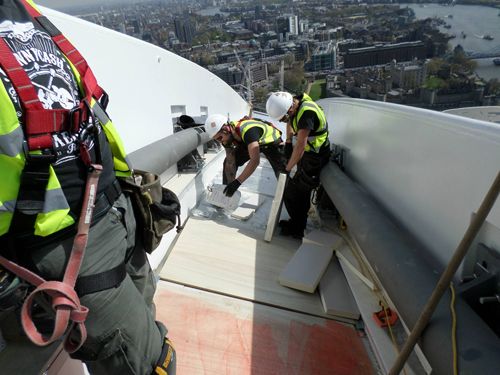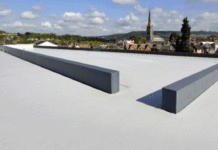 On April 6 2015, a new version of the Construction (Design and Management) Regulations (CDM 2015) was introduced by the Health and Safety Executive (HSE). As we are now coming to the end of the transitional period between the old procedures and the new, are you confident that everyone involved in your construction project knows their responsibilities? It is vital that the profession is ready to work within this revised framework, as failing to follow the regulations could result in prosecution.
On April 6 2015, a new version of the Construction (Design and Management) Regulations (CDM 2015) was introduced by the Health and Safety Executive (HSE). As we are now coming to the end of the transitional period between the old procedures and the new, are you confident that everyone involved in your construction project knows their responsibilities? It is vital that the profession is ready to work within this revised framework, as failing to follow the regulations could result in prosecution.
These CDM regulations effect almost everybody involved in construction, including clients, designers and contractors – referred to as ‘duty holders’ – from the start of a project to final demolition, and are applied to all sites.
An update of the original regulations, introduced in 2007 as a means of improving health and safety on UK construction sites, CDM 2015 has a greater focus on smaller projects, as well as placing new obligations on clients and facilities managers. Changes include extending the scope of the regulations to include domestic clients, removing the role of the CDM coordinator and introducing a new duty holder, the principal designer. A principal designer and principal contractor must now be appointed on all schemes where two or more contractors are on site.
The HSE recognised that there would be construction projects that started before the CDM 2015 regulations came into force, and that would continue beyond that date. For these projects, with more than one contractor involved, the transitional arrangements have applied, but these came to an end at the beginning of October.
If the construction phase had not yet started when CDM 2015 came into place and the client had not appointed a CDM coordinator, a principal designer had to be appointed as soon as possible. However, if the CDM coordinator had already been appointed, the client must have appointed a principal designer to replace the CDM coordinator by October 6 2015, unless the project is/was completed before then.
As these transitional obligations have now come to an end, all projects should be operating under the new CDM 2015 regulations and all principle designers should be in place. It is extremely important that all parties are aware of the exact details of these regulations, in order to protect and reduce the risk of harm to those who have to build, use and maintain structures. Anything that helps to reduce accidents is to be encouraged – especially when, even with the reduction in fatalities over the last four decades, there are still over 40 deaths annually on construction sites. This is well above other sectors when calculated on a per employee basis – around 31% against a 5% average for all employees in Great Britain.
Where a roofing manufacturer is giving design and specification advice, it is our duty to inform the client of its responsibilities under the regulations. But what is the obligation of the other parties involved in a project? Make sure you’re up to date with Sika Sarnafil’s quick guide to CDM 2015.
Key responsibilities in CDM 2015
The client
Under CDM 2007, the CDM coordinator was the client’s key safety adviser. The removal of this role therefore has a significant impact on project safety governance. If you are a client, you must make suitable arrangements for managing a project, including the allocation of time and other resources. Clients’ key responsibilities include:
- Notifying the HSE of the project details and confirming that the project team are aware of their duties
- Ensuring duty holders comply with their duties
- Providing the pre-construction information
- Ensuring that the minimum health and safety standards are maintained on site
- Ensuring that the construction phase health and safety plan is drawn up by the principal contractor
- Ensuring that a health and safety file is produced by the principal designer
Perhaps the client’s most important duty is to appoint a principal designer and principal contractor, which are mandatory on projects with more than one contractor. In practice, these duty holders will carry out many of the functions listed above – although it is still the client’s duty to ensure that they are performing their roles. The client must make these two appointments ‘as soon as practicable’. In particular, the principal designer should be appointed as early as possible in the design process, ideally at concept stage. This will help the client to pull together the preconstruction information, such as asbestos surveys, existing health and safety files and structural drawings. Failure to make these appointments will see their duties transfer automatically to the client.
The principal designer
The new role of principal designer takes on many of the duties of the CDM coordinator – although it is not a direct replacement. The principal designer must plan, manage, monitor and coordinate health and safety in the pre-construction phase of a project. This includes:
- Identifying, eliminating or controlling foreseeable risks
- Ensuring designers carry out their duties
- Preparing and providing relevant information to other duty holders
- Providing relevant information to the principal contractor to help them plan, manage, monitor and coordinate health and safety in the construction phase
The principal designer does not need to be the lead designer on the project, and it should never be assumed that the lead designer takes on this role by default – the appointment must be made in writing. CDM 2015 includes in its definition of designers: ‘architects, architectural technologists, consulting engineers, quantity surveyors, interior designers, temporary works engineers, chartered surveyors, technicians or anyone who specifies or alters a design’. It also states that the principal designer must be ‘an organisation or an individual with sufficient knowledge, experience and ability to carry out the role’.
The principal contractor
This remains largely unchanged from CDM 2007. The principal contractor must plan, manage, monitor and coordinate health and safety in the construction phase of a project. This includes:
- Liaising with the client and principal designer
- Preparing the construction phase plan
- Organising cooperation between contractors and coordinating their work
- Ensuring suitable site conditions are provided
Notification threshold
Under CDM 2015, the HSE will need to be notified about projects exceeding 500 person days or ‘longer than 30 working days’ with ‘more than 20 workers working simultaneously’. This should have the effect of reducing the number of notifiable projects. The easiest way to notify any project to the HSE or other relevant enforcing authority is to use the online notification form F10 on the HSE’s website. It is important to note that clients, designers and contractors still have responsibilities for those projects for which the HSE does not require notification.



